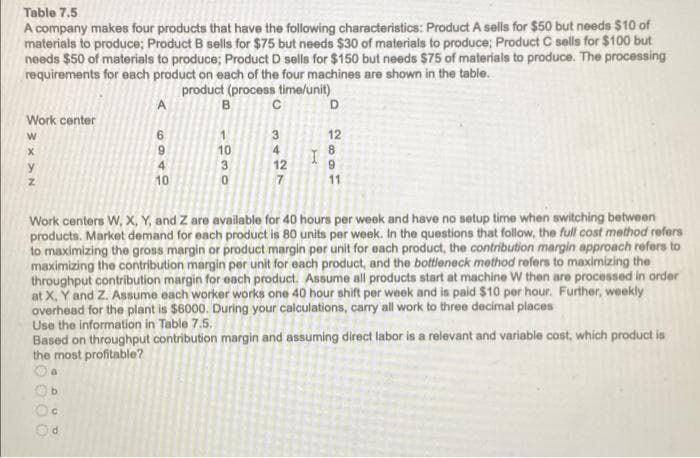A company makes four products that have the following characteristics: Product A sells for $50 but needs $10 of materials to produce; Product B sells for $75 but needs $30 of materials to produce; Product C sells for $100 but needs $50 of materials to produce; Product D sells for $150 but needs $75 of materials to produce. The processing requirements for each product on each of the four machines are shown in the table. product (process time/unit)
A company makes four products that have the following characteristics: Product A sells for $50 but needs $10 of materials to produce; Product B sells for $75 but needs $30 of materials to produce; Product C sells for $100 but needs $50 of materials to produce; Product D sells for $150 but needs $75 of materials to produce. The processing requirements for each product on each of the four machines are shown in the table. product (process time/unit)
Essentials of Business Analytics (MindTap Course List)
2nd Edition
ISBN:9781305627734
Author:Jeffrey D. Camm, James J. Cochran, Michael J. Fry, Jeffrey W. Ohlmann, David R. Anderson
Publisher:Jeffrey D. Camm, James J. Cochran, Michael J. Fry, Jeffrey W. Ohlmann, David R. Anderson
Chapter12: Integer Linear Optimization_models
Section: Chapter Questions
Problem 6P: Hart Manufacturing makes three products. Each product requires manufacturing operations in three...
Related questions
Question

Transcribed Image Text:Table 7.5
A company makes four products that have the following characteristics: Product A sells for $50 but needs $10 of
materials to produce; Product B sells for $75 but needs $30 of materials to produce; Product C sells for $100 but
needs $50 of materials to produce; Product D sells for $150 but needs $75 of materials to produce. The processing
requirements for each product on each of the four machines are shown in the table.
product (process time/unit)
A
B
C
D
Work center
W
6
3
12
X
9
10
4
8
4
y
12
9
Z
10
7
11
Work centers W, X, Y, and Z are available for 40 hours per week and have no setup time when switching between
products. Market demand for each product is 80 units per week. In the questions that follow, the full cost method refers
to maximizing the gross margin or product margin per unit for each product, the contribution margin approach refers to
maximizing the contribution margin per unit for each product, and the bottleneck method refers to maximizing the
throughput contribution margin for each product. Assume all products start at machine W then are processed in order
at X, Y and Z. Assume each worker works one 40 hour shift per week and is paid $10 per hour. Further, weekly
overhead for the plant is $6000. During your calculations, carry all work to three decimal places
Use the information in Table 7.5.
Based on throughput contribution margin and assuming direct labor is a relevant and variable cost, which product is
the most profitable?
0000
COUP
Expert Solution
This question has been solved!
Explore an expertly crafted, step-by-step solution for a thorough understanding of key concepts.
Step by step
Solved in 3 steps with 2 images

Knowledge Booster
Learn more about
Need a deep-dive on the concept behind this application? Look no further. Learn more about this topic, accounting and related others by exploring similar questions and additional content below.Recommended textbooks for you

Essentials of Business Analytics (MindTap Course …
Statistics
ISBN:
9781305627734
Author:
Jeffrey D. Camm, James J. Cochran, Michael J. Fry, Jeffrey W. Ohlmann, David R. Anderson
Publisher:
Cengage Learning

Cornerstones of Cost Management (Cornerstones Ser…
Accounting
ISBN:
9781305970663
Author:
Don R. Hansen, Maryanne M. Mowen
Publisher:
Cengage Learning

Principles of Accounting Volume 2
Accounting
ISBN:
9781947172609
Author:
OpenStax
Publisher:
OpenStax College

Essentials of Business Analytics (MindTap Course …
Statistics
ISBN:
9781305627734
Author:
Jeffrey D. Camm, James J. Cochran, Michael J. Fry, Jeffrey W. Ohlmann, David R. Anderson
Publisher:
Cengage Learning

Cornerstones of Cost Management (Cornerstones Ser…
Accounting
ISBN:
9781305970663
Author:
Don R. Hansen, Maryanne M. Mowen
Publisher:
Cengage Learning

Principles of Accounting Volume 2
Accounting
ISBN:
9781947172609
Author:
OpenStax
Publisher:
OpenStax College

Managerial Accounting: The Cornerstone of Busines…
Accounting
ISBN:
9781337115773
Author:
Maryanne M. Mowen, Don R. Hansen, Dan L. Heitger
Publisher:
Cengage Learning

Financial And Managerial Accounting
Accounting
ISBN:
9781337902663
Author:
WARREN, Carl S.
Publisher:
Cengage Learning,

Managerial Accounting
Accounting
ISBN:
9781337912020
Author:
Carl Warren, Ph.d. Cma William B. Tayler
Publisher:
South-Western College Pub